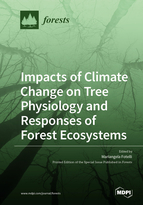Impacts of Climate Change on Tree Physiology and Responses of Forest Ecosystems
A special issue of Forests (ISSN 1999-4907). This special issue belongs to the section "Forest Ecophysiology and Biology".
Deadline for manuscript submissions: closed (15 April 2021) | Viewed by 38789
Special Issue Editor
Special Issue Information
Dear Colleagues,
Climate change-induced extreme events, such as heat waves, prolonged droughts, and floodings, are increasingly evident. The intensity, frequency, and spatial distribution of such adverse climate phenomena are noticeable. However, forest trees may develop remarkable physiological mechanisms to cope with constantly changing and challenging environmental regimes caused by global warming, rising atmospheric carbon dioxide, largely fluctuating water availability, elevated nitrogen depositions, and others. Whether physiological resilience and resistance on the tree level result in ecophysiological responses that ensure plasticity of forest ecosystems to the concurrent climate change or if, on the contrary, forests may be severely damaged by climate change are core questions of contemporary forest research.
This Special Issue of Forests aims at exploring the state of knowledge and progress on key aspects of tree physiology and forest ecophysiology in light of climate change. We welcome original research papers from the leaf to the ecosystem level, based on experimental, theoretical, or modeling approaches, as well as review articles.
Dr. Mariangela Fotelli
Guest Editor
Manuscript Submission Information
Manuscripts should be submitted online at www.mdpi.com by registering and logging in to this website. Once you are registered, click here to go to the submission form. Manuscripts can be submitted until the deadline. All submissions that pass pre-check are peer-reviewed. Accepted papers will be published continuously in the journal (as soon as accepted) and will be listed together on the special issue website. Research articles, review articles as well as short communications are invited. For planned papers, a title and short abstract (about 100 words) can be sent to the Editorial Office for announcement on this website.
Submitted manuscripts should not have been published previously, nor be under consideration for publication elsewhere (except conference proceedings papers). All manuscripts are thoroughly refereed through a single-blind peer-review process. A guide for authors and other relevant information for submission of manuscripts is available on the Instructions for Authors page. Forests is an international peer-reviewed open access monthly journal published by MDPI.
Please visit the Instructions for Authors page before submitting a manuscript. The Article Processing Charge (APC) for publication in this open access journal is 2600 CHF (Swiss Francs). Submitted papers should be well formatted and use good English. Authors may use MDPI's English editing service prior to publication or during author revisions.
Keywords
- Climate change
- Forest ecophysiology
- Tree physiology
- Physiological acclimation
- Water relations and fluxes
- Nutrient metabolism
- Nitrogen and carbon balance
- Secondary metabolites






